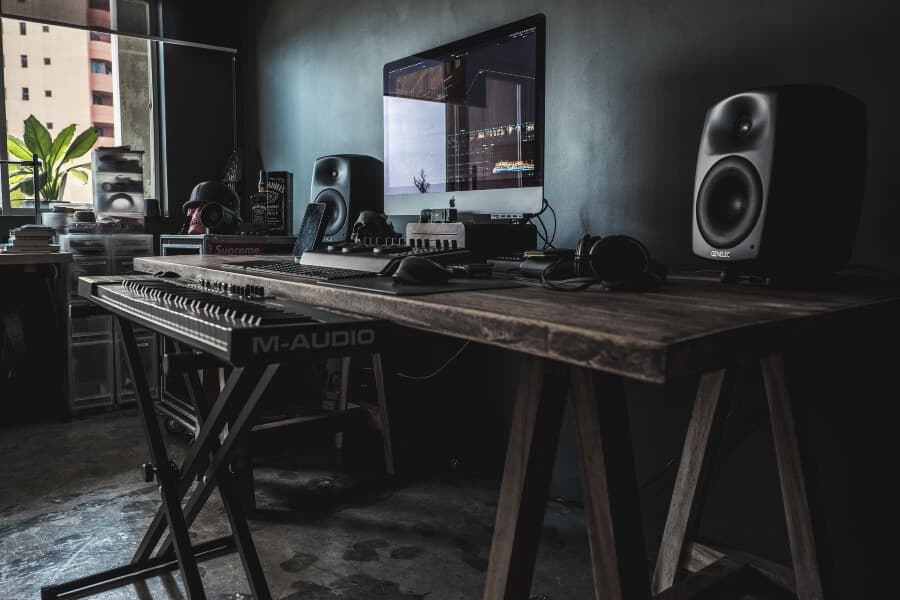
Types of Monitor Speakers
Choosing a set of monitor speakers is crucial when designing a home studio for music production, mixing, and mastering audio. No, regular speakers won’t work. While admittedly similar to regular speakers, at least to an untrained eye, studio monitors are basically loudspeakers placed in enclosures that are specifically designed for professional audio production.
As such, they’re used in recording studios, filmmaking, television and radio studios, and in all applications that require accurate audio reproduction. What separates them from regular speakers is the fact that the latter is designed to enhance the music played through them, aiming to impress with exaggerated bass, harsh treble, and overhyped mid-range.
Monitors, however, are designed to reveal the true sound of the audio signal coming through the speakers. This allows you to make critical adjustments, confident that what you’re hearing will translate to other playback systems. With that said, not all monitors are made equal, and in this guide, we’ll go over the basic types of monitor speakers.
Passive vs. Active Monitor Speakers
Passive and active monitors are two different types of monitors, and the distinction is made with respect to amplification. Audio signals entering the monitor speaker have to be amplified before being outputted through the drivers.
Passive monitors need external amplifiers to amplify the input signal before entering the monitor. Thus, the monitor doesn’t actually require any power supply. Conversely, active monitors don’t require external amplification since the amplifiers are housed within the monitor cabinet (housing).
The choice between the two really depends on your needs, but neither type is necessarily superior to the other. Still, home studios typically rely on active speakers, as they eliminate the need for bulky amp units and audio racks.
Nearfield Monitors
Monitors sound differently depending on the distance, and nearfield monitors are designed to be used in near proximity to the listener—usually 3-5 feet away. These are great for smaller studios and studio control rooms, as their close placement reduces the impact of room acoustics.
Midfield Monitors
Midfield monitors are specifically designed to be placed further from the listener (around 6-10 feet) and further apart from one another, which makes them great for wide soundstages and greater volume levels compared to nearfield monitors.
Main Monitors
Main monitors, also called far-field monitors, are large, powerful monitor speakers that are typically built into the walls of professional audio studios or at concert stages since they’re designed to output extremely high sound volume levels.
2-Way vs. 3-Way Monitors
This refers to the number of drivers or speakers that the monitor had. 2-way monitors use two drivers: a woofer for producing lower frequencies (bass), and a tweeter, for reproducing high frequencies (treble).
Audio signals are separated by a crossover filter that splits the input into low and high bands. More affordable models tend to have a crossover point in the mid-range. That’s why higher-end models sport a three-way design, keeping the midrange frequencies free of crossover. This adds a third driver to the mix, which acts as a mid-range speaker.
This driver reproduced middle frequencies, which is where much of the content in music and other audio resides. Furthermore, adding a mid-range driver allows the woofer and tweeter to focus more specifically on their respective frequency bands, resulting in a clearer, more accurate sound reproduction.
Bi-amped vs. Tri-amped Monitors
Bi-amping and tri-amping refer to different amplification techniques used to further improve the performance of the multi-driver speaker systems. The former implies that the audio signal is split into two frequency ranges by an active crossover before amplification. As discussed above, each range is amplified separately and then sent to its corresponding driver.
The same applies to tri-amping, which is used in 3-way monitor systems. The signal is split into three frequency ranges before amplification, and each range is then sent to its respective driver, resulting in cleaner, more accurate sound reproduction.
Summary
In summary, these classifications can be combined; for example, you can have an active 2-way near-field monitor setup or passive 3-way far-field monitor speakers with front-facing ports. The choice of a specific monitor greatly depends on your specific needs, the specific need of your studio, and your personal preferences.